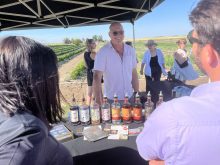Few raised their hands when a crowd of 200 Calgary suburbanites were asked how many had been on a farm in the last 20 years.
Yet this group that gathered at a community hall in one of the city’s upscale neighbourhoods gave up a Saturday afternoon to meet farmers and learn how to buy locally produced food.
Titled Local 101, the event brought together chefs, the public and farmers to talk about what it takes to get fresh farm food to the cities.
Organizer Wade Sirois, a Calgary chef and caterer, said it is time to get back to basics because local food is not cheap and requires attention on the part of what he calls co-producers, the people who eat the food.
Read Also

Vintage power on display at Saskatchewan tractor pull
At the Ag in Motion farm show held earlier this year near Langham, Sask., a vintage tractor pull event drew pretty significant crowds of show goers, who were mostly farmers.
“You are going to cook again. You are going to have to get back in the kitchen,” he said.
“What is out there isn’t really convenient.”
As a professional cook, he works with about 40 farmers year round to fill 70 percent of his menus with Alberta product. It would be easier to place a two minute call to the wholesaler, but he spends up to eight hours a week ordering from local farmers.
He encouraged consumers to ask where their food comes from when they go to restaurants. Chances are the servers have no idea. He also dismissed the 100 mile diet as restrictive and absurd because the entire province can provide everything that is required to fill home larders.
However, home grown is more expensive and most consumers still tend to shop by price at a mainstream grocer and miss out on tasty, fresh products. The main problem is dealing with seasonality and finding enough volume, but adjustments can be made, he said.
Chef Mark Klaudt, who runs the Route 40 Soup Company at Turner Valley, Alta., and buys local, said he spends as much as $130,000 a year on food for the café. He sells his soups at his café and at farmers’ markets.
Born on a Saskatchewan farm, Klaudt wanted the crowd to understand what it costs farmers to produce food.
For example, a greenhouse operator may spend $15,000 to $20,000 on natural gas each month as well as local taxes, land costs, equipment, staff and packaging.
“People don’t see what it takes to get that food to market,” he said.
Two southern Alberta farmers who direct market said the path they have chosen is never smooth.
Chris Vester owns Blue Mountain Biodynamic Farm, an organic mixed operation at Carstairs, Alta. He sells direct and supplies local restaurants but is dismayed when he has to compete at the farmers’ markets with wholesalers who are reselling products.
He has also noticed many organic food stores import their food and are often more interested in selling health products rather than fresh, local produce.
Peter and Judy Haase sell bison directly to customers year round from their Buffalo Horn Ranch near Olds, Alta.
Starting the farm was difficult because bankers weren’t interested in financing their concept. They sold their home in Calgary and used the proceeds to buy their original bison herd and build a customer base.
While they can include their cost of production in their final meat price, they have struggled along with other livestock producers against drought, grasshoppers and BSE restrictions.
Haase advised farmers to find something different if they want to direct market.
“Do not try to produce a product that competes directly with what you can get at Superstore.”
He fears many farmers have lost touch with food production and prefer the easy route by hauling grain to an elevator owned by a multinational company or taking their livestock to the auction and accepting whatever bid is offered that day.
He said for many farmers the land has become an investment plan that can be turned into something of higher value such as a subdivision, mall or golf course.
Farmers who hope to market home-raised products through a retail outlet should be prepared to put up with seasonality and buyers who do not pay within 60 days.
People who say they want locally produced food must also be prepared to make sacrifices.
“When you want to support local agriculture, you have to limit your shopping in the local grocery stores,” Haase said.
Consumers need to support farmers’ markets regularly.
“If you want this product you have to come to the market, rain or shine. If you are willing to make a commitment to buy our food, we are willing to grow it for you.”

















